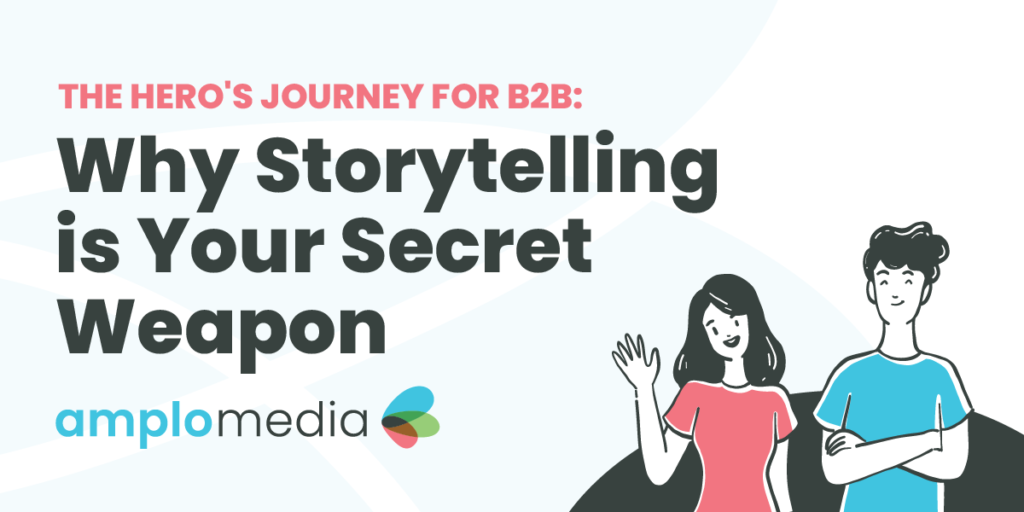Imagine this: You’re a B2B service provider offering top-notch services to businesses. You have data-driven solutions, expert staff, and a proven track record. Yet, leads are lukewarm, and conversions feel like pulling teeth. Sound familiar?
Here’s the truth: in today’s saturated B2B landscape, facts and features just don’t cut it anymore. You need a way to connect with your ideal customer on an emotional level, to show them not just what you do but how you can transform their business.
Enter the power of storytelling.
Why Stories Sell
Think back to your favourite movie. What kept you glued to the screen? It wasn’t just the plot, it was the characters’ journeys, their struggles, triumphs, and the emotional connection you formed with them.
Storytelling, at its core, taps into the human desire to connect. It allows us to identify with characters, understand their needs, and root for their success. B2B is no different. By weaving your message into a compelling narrative, you can:
- Capture attention: In a sea of facts and figures, a well-crafted story stands out, drawing your audience in.
- Build trust: Sharing your brand’s story, its challenges and successes, humanizes you and builds trust with potential clients.
- Spark empathy: By showcasing your ideal customer’s pain points and aspirations, you connect with them on a deeper level.
- Drive action: A powerful story motivates your audience to take the next step, whether it’s contacting you or learning more.
The StoryBrand Framework: A Brief Overview
The StoryBrand framework, developed by renowned author Donald Miller, is a storytelling and messaging strategy that has been embraced by businesses worldwide. At its core, it recognizes that every compelling story has a hero (your customer), a problem, a guide (your business), a plan, a call to action, and a successful outcome (a thriving, profitable business).
Let’s take a fictitious bookkeeping company, “Profitable Numbers Inc.,” as an example to understand how this framework can transform a B2B company:

Implementing Brand Storytelling in Your B2B Content Marketing Strategy
Now that we understand the benefits of storytelling in B2B content marketing, let’s explore how you can implement it effectively in your own strategy.
1. Identify your brand’s core values and purpose: To create a compelling brand story, start by identifying your brand’s core values and purpose. What do you stand for? What sets you apart from your competitors? Understanding and articulating these core elements will help guide your storytelling efforts and create a clear and consistent brand narrative.
“Storytelling helps businesses simplify complex messages, making it easier for potential clients to understand what they offer. This clarity is essential in the often jargon-heavy world of B2B services.”
2. Understand your target audience: To connect with your audience, you need to understand their needs, what pains them, and their aspirations. Conduct thorough research to identify your target audience’s motivations, challenges, and goals. This will allow you to tailor your brand story to resonate with their experiences and create a deeper emotional connection.
“A well-crafted brand story creates an emotional connection with your audience, which makes them more likely to remember your message and choose your services over competitors. When clients relate to your story, they become more loyal.”
3. Craft a compelling narrative: Once you have a solid understanding of your brand’s values and your target audience, it’s time to craft a compelling narrative. Your brand story should follow the structure of the hero’s journey, positioning your ideal customers as the heroes of the story and your brand as the guide. Showcase how your product or service can help them overcome their challenges and achieve success.
“Positioning your business as the guide in the hero’s journey fosters trust and authority. When clients see you as the expert who can help them achieve their goals, they are more likely to choose your services.”
4. Incorporate storytelling into your content: To effectively implement brand storytelling, incorporate it into your content across various channels and formats. Whether it’s blog posts, videos, social media campaigns, or case studies, infuse your content with storytelling elements. Use relatable characters, emotional storytelling, and a consistent brand voice to engage your audience and create a memorable brand experience.
“In crowded marketplaces, storytelling can set your business apart. It showcases your unique value proposition and the positive outcomes you can deliver, making your services more appealing.”
5. Measure and refine your storytelling efforts: As with any marketing strategy, it’s important to measure the effectiveness of your brand storytelling efforts. Use analytics to track engagement, conversions, and customer feedback. This data will help you identify what resonates with your audience and refine your storytelling approach over time.
“A compelling story with a clear call to action prompts potential clients to take the next step. Whether it’s scheduling a consultation, requesting a quote, or signing up for a newsletter, storytelling guides prospects toward conversion.”
In a world where businesses are constantly vying for the attention of potential clients, storytelling can be a powerful tool to engage, connect, and convert. Leveraging a storytelling framework enables clients, like the fictitious Profitable Numbers Inc., to create compelling brand stories that resonate with their B2B audience. By placing the customer as the hero, identifying their challenges, and positioning themselves as the trusted guide, businesses can achieve greater success in the competitive landscape.
If you’re ready to transform your B2B business and elevate your brand messaging, contact Amplomedia today. Together, we can craft a story that captivates your audience, drives results, and sets your business on a path to success.

